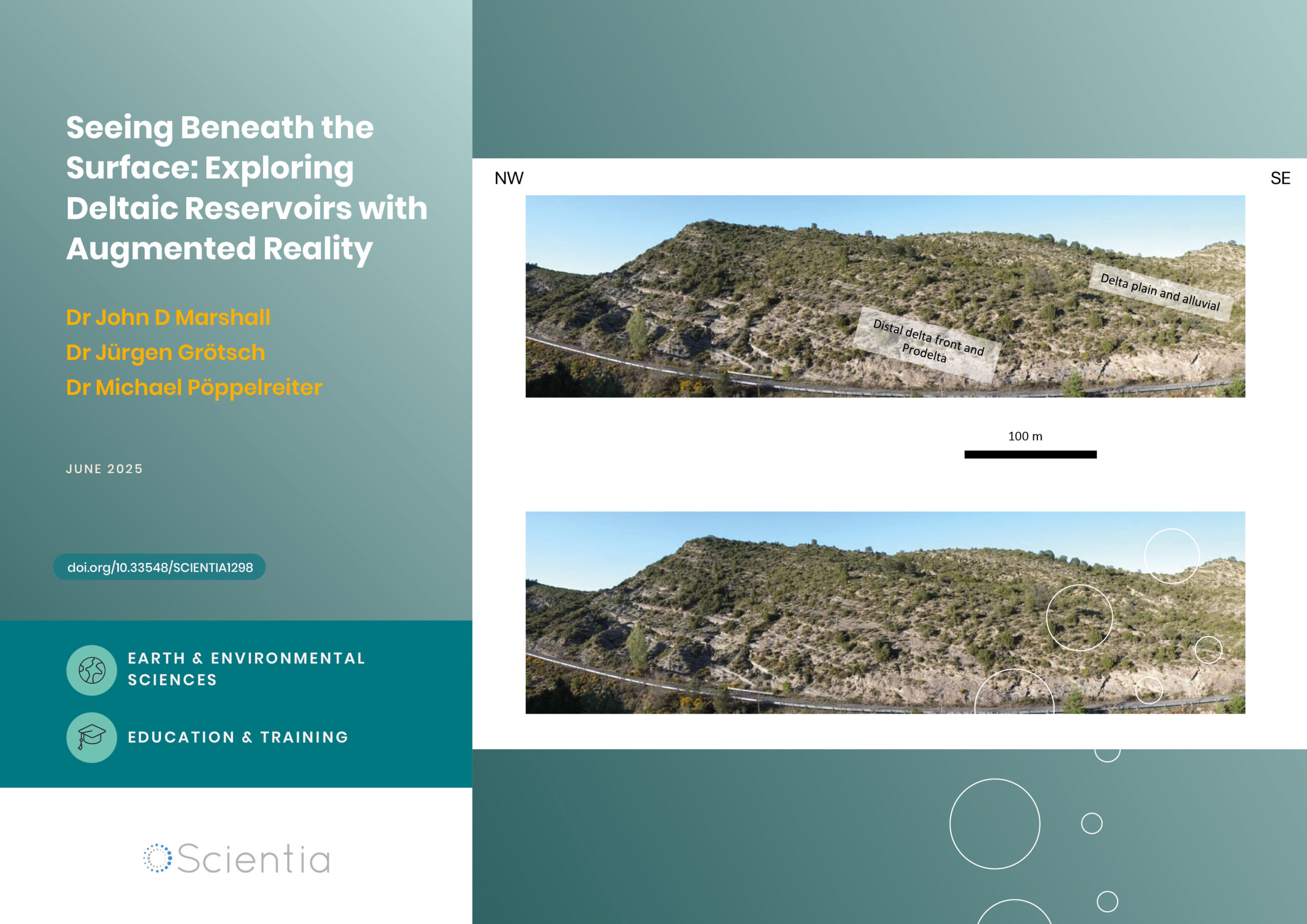Dr Shadia Habbal | Dr Miloslav Druckmüller – Hiding the Sun: Coronal Discoveries during Total Solar Eclipses
Extending far beyond its surface, the Sun’s corona hosts a variety of intricate structures and behaviours. Yet because the Sun is so much brighter than its surrounding environment, these properties can be incredibly hard to spot under typical observing conditions. In their research, Dr Shadia Habbal at the University of Hawaii and Dr Miloslav Druckmüller at Brno University make use of one of the most well-known astronomical phenomena to solve this issue: total solar eclipses.
The Sun’s Complex Behaviours
Over the past decades, astronomers have learnt much about the vast yet intricate processes that play out both on the Sun’s surface, and deep within its interior. However, the complex behaviours of our host star cannot be explained by observing these properties alone. In fact, a vibrant array of physical processes also occurs in the Sun’s surrounding environment, known as its ‘corona’. While it is easy to observe the Sun’s surface with the right equipment, the corona is far dimmer within the range of wavelengths that our eyes perceive as light. This makes the corona far more difficult to study.
‘The visible surface, or “photosphere” of the Sun emits in the visible wavelength range, but it is a million times brighter than the corona,’ explains Shadia Habbal, of the University of Hawaii. ‘Therefore, we need to block the solar disk and photosphere to see what is happening in the corona.’ Astronomers can partially solve this problem using a telescope attachment called a ‘coronagraph’, which artificially obscures the Sun’s surface with an opaque disc. However, this technique is limited by factors including diffraction, which makes observing the innermost corona impossible, as well as scattering from the Earth’s atmosphere, which decreases the contrast of coronal features significantly.
Alternatively, they can make observations in the extreme ultraviolet (EUV) range of wavelengths, instead of the visible. The solar photosphere appears as a black sphere emitting no light in the EUV range and therefore it does not need to be obscured. This makes studying the solar corona far easier. However, this technique requires access to space, and isn’t without its shortcomings.
‘In the EUV, the corona is visible both on the solar disk and over some distance away from its surface,’ continues Dr Habbal. ‘This provides a way to track the connection between features on the surface, as they project outwards, away from the Sun. However, the extension of the EUV emission beyond the surface of the Sun is limited to about a quarter of its radius. This is too short a distance to be able to follow the features as they change and evolve rapidly during their expansion away from the Sun.’ To solve this issue, astronomers need a way to easily view the visible wavelengths emitted by the corona.
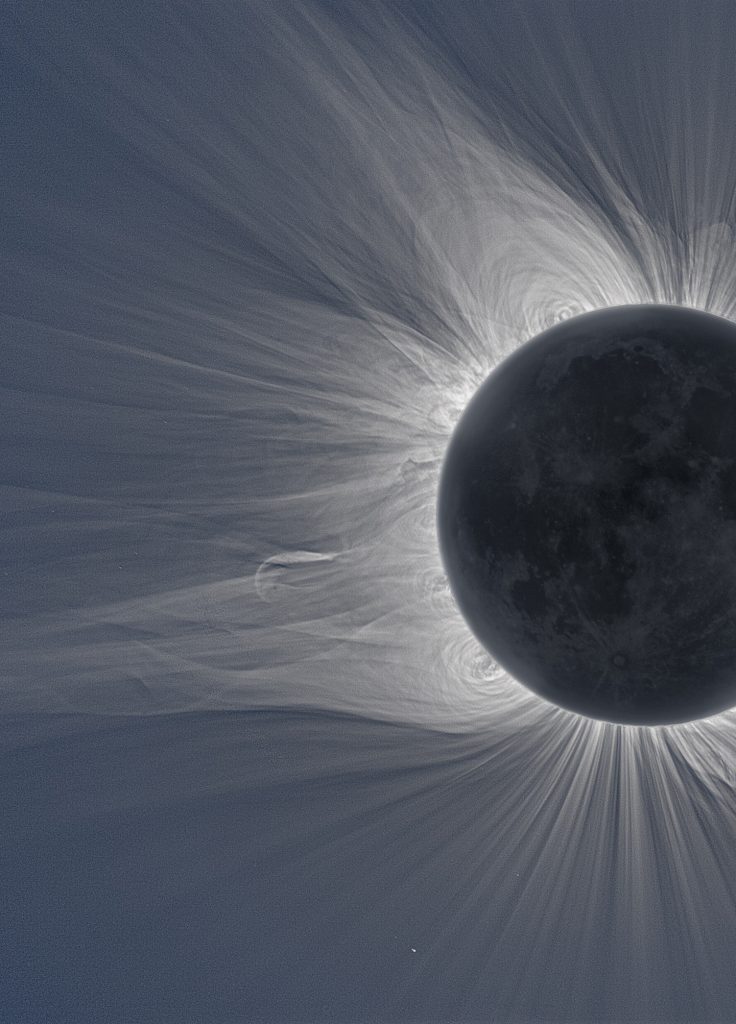
Solar corona during total solar eclipse of July 11, 2010. CREDIT: Miloslav Druckmüller, Martin Dietzel, Shadia Habbal, Vojtech Rušin.
Searching Far from the Surface
Thankfully, one completely natural quirk of the solar system’s dynamics has provided astronomers with the ideal solution to tackle this problem. The relative sizes of the Moon and the Sun, combined with their relative distances from Earth, mean that the Moon can almost perfectly obscure the solar disc when viewed from just the right position on Earth, and at just the right time. When this occurs, the motion of the Moon’s shadow projects a dark band onto the Earth’s surface, ranging from only several kilometres to around 100 kilometres wide, and a few thousands of kilometres long, which changes from one eclipse to another.
For a few crucial moments – lasting from a few seconds to seven minutes – the corona alone is visible beyond the obscuring Moon’s surface, extremely close to the edge, or ‘limb’ of the Sun, out to distances several times the Sun’s radius. This gives astronomers access to ideal conditions for observing coronal plasmas and streams of charged particles called the solar wind.
‘In the visible, the coronal emission can be observed to much larger distances from the Sun,’ describes Dr Habbal. ‘Total solar eclipses provide the best observing conditions to capture that extent. In white light, one can capture the corona out to tens of solar radii. We can also observe specific emission lines in the visible range, produced by ions from elements such as iron, magnesium and nickel, which can be observed out to 2–3 solar radii.’
Clearly, these ranges extend far beyond those reached by emissions of EUV light in the corona. This means that by searching for visible light emission during a total solar eclipse, in combination with EUV emission, Dr Habbal, Dr Druckmüller and their team can gather far more extensive data about the properties of the corona as a whole. In particular, they are interested in studying the behaviours of plasmas and solar wind in the Sun’s surrounding environment, which give rise to a variety of intriguing properties as they form and evolve over time.
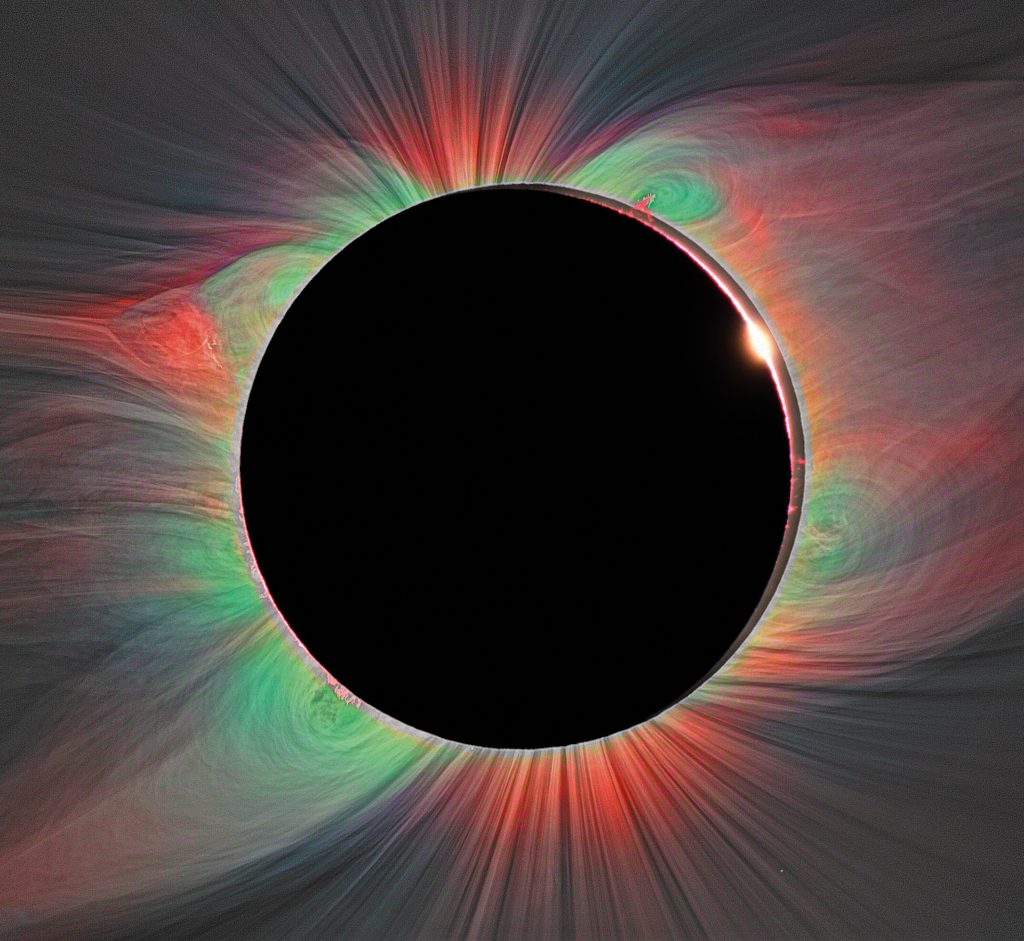
Solar corona during total solar eclipse of August 1, 2008 with enhanced emission of iron ions. The green colour represents Fe XIV and the red one represents Fe XI. CREDIT: Miloslav Druckmüller, Shadia Habbal, Peter Aniol.
Revealing Magnetic Structures
Unlike the Earth’s magnetic field, which forms a simple loop connecting the north and south poles, the Sun’s magnetic field is highly complex and dynamic. Since the Sun rotates faster at its equator than towards its poles, the varying motions of plasmas in its interior result in magnetic fields that become wound up into complicated patterns of twists and knots. As these fields expand, they pass through coronal gases with different densities and temperatures, creating even more complex patterns. Over time, this means that highly intricate magnetic structures will arise in the corona, which themselves give rise to a variety of interesting phenomena as they evolve.
Dr Habbal and Dr Druckmüller’s group are particularly interested in the evolution of magnetic structures named ‘prominences’ – small, bright features made up of neutral and low ionised gases, which are anchored to the Sun’s surface. Despite being cloaked in extremely hot plasma, reaching temperatures of over one million degrees, prominences themselves maintain temperatures around 100 times cooler, and are also around 100 times denser than their surroundings. By searching for evidence of these structures close to the solar surface in the visible wavelength range, the group aims to establish the role that prominences play in the behaviour of the corona as a whole.
‘Through imaging in white light and a selection of emission lines from known ions in the corona, we search for the connection between prominences and the overlying and surrounding coronal structures,’ Dr Habbal describes. ‘Prominence material shows up in eclipse images in spectral lines in the visible range, which are produced by the excitation of neutral and low ionised atoms. What we have seen are cool prominence materials embedded in the hotter surrounding material.’ By studying these prominences, and the surrounding plasmas that indicate their presence, Dr Habbal and Dr Druckmuller’s team can link their properties to coronal phenomena on far larger scales.
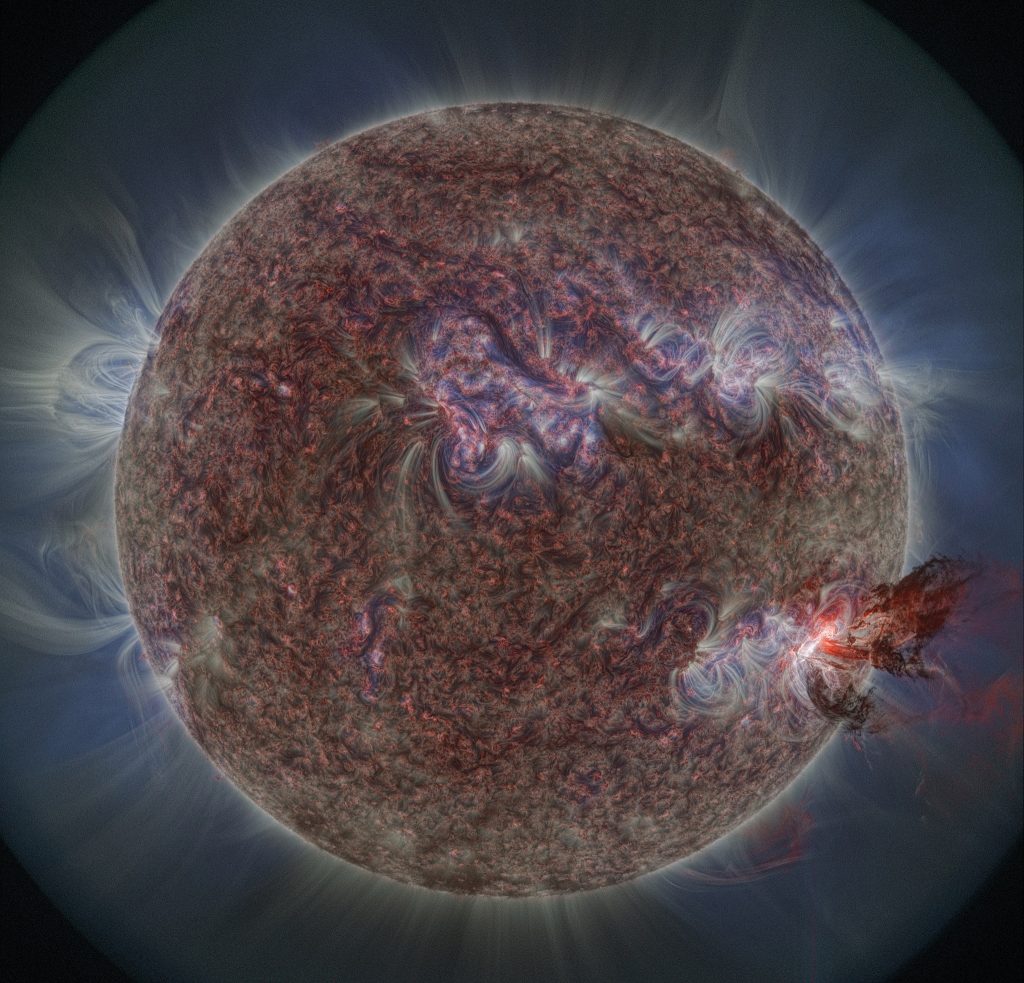
Solar corona in the extreme ultraviolet light taken by the AIA instrument on SDO, during a significant flare and following a huge prominence eruption on June 7, 2011. The image was created by Miloslav Druckmüller, by applying his PM-NAFE technique.
Connecting Prominences with Coronal Mass Ejections
Compared with coronal plasmas and solar wind, the magnetic structures of prominences are highly complex, making them highly dynamic. This means that prominences may evolve rapidly over time, and will also erupt frequently, spewing some of their gases into space, while the rest falls back down to the solar surface. This behaviour is strongly linked to that of coronal mass ejections (CMEs) – vast releases of plasmas into the solar wind, which often precede or follow solar flares into interplanetary space. While many aspects of prominences, including their formation, cool temperatures, and densely packed, low-ionised material remain a mystery, Dr Habbal and Dr Druckmüller’s team believe they have now found indisputable evidence that they are connected with CME formation.
‘Prominences are the “release button” of CMEs,’ Dr Habbal describes. ‘A lot of turbulent motions are observed in the immediate vicinity of prominences, whose origin we still need to understand. At instances when prominences are caught detached or semi-detached from the solar surface, they will be most likely associated with CMEs.’ In their total solar eclipse observations, Dr Habbal, Dr Druckmüller and their team have confirmed that as prominences erupt and unravel, they accelerate the hot plasma surrounding them to speeds of thousands of kilometres per second. Clearly, the properties of these structures have profound effects on the behaviour of the corona as a whole.
The group has also made an unexpected new discovery through observations of ionic emission lines, whose wavelengths have been shifted from our perspective due to the Doppler effect. The shifts suggest that blobs of cold, dense prominence material are travelling into interplanetary space at speeds of between 100 and 1500 kilometres per second. Furthermore, these blobs remain cloaked in hot CME material as they travel, yet still appear to escape the corona unscathed; creating a source of low-ionised interplanetary material. Such strange behaviour highlights just how much we have left to learn about the Sun and its surrounding environment.
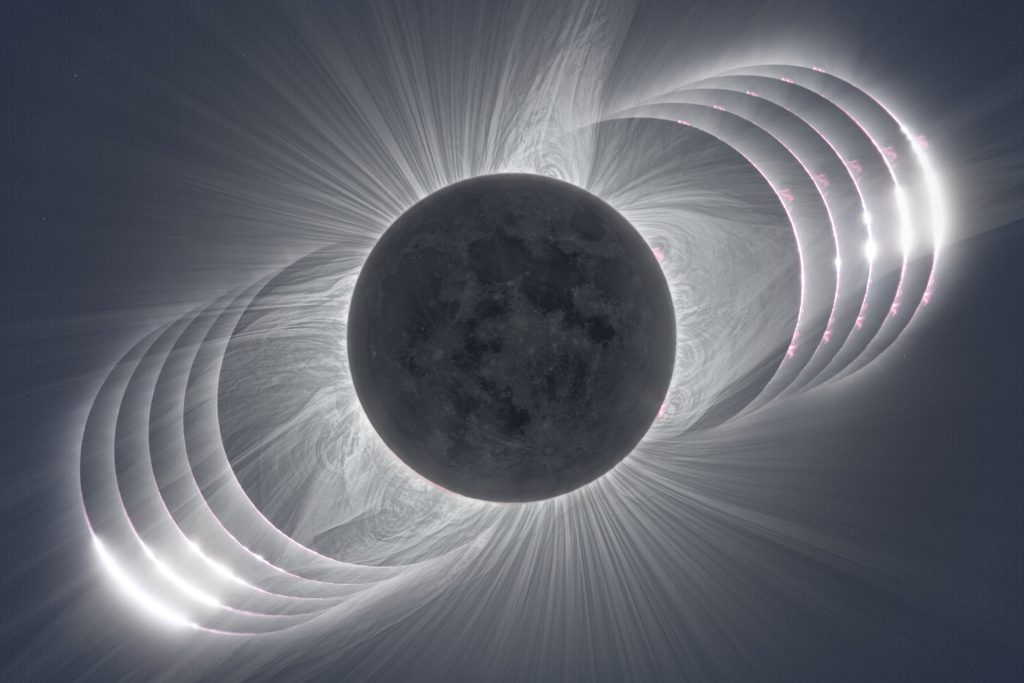
Total solar eclipse of August 21, 2017, solar corona and Baily’s beads before and after the total eclipse. CREDIT: Miloslav Druckmüller, Petr Horálek, Shadia Habbal.
Uncovering the Mysteries of the Corona
Dr Habbal, Dr Druckmüller and their colleagues have now made a wide variety of discoveries – many of them from observations of the total solar eclipse that darkened the arctic island of Svalbard in March 2015, as well as the more famous event that travelled the entire width of the continental US in August 2017. Through their continuing studies, the group is now searching for connections with other unexplained behaviours, including accelerations of different types of solar wind, namely the fast and the slow, and flows of heat within the corona.
Such studies would have limited impact through observations made by a coronograph, or in the EUV alone. However, through the techniques they have developed, Dr Habbal and Dr Druckmüller’s team can now realistically aim to measure properties including the chemical compositions and ionisation states of coronal material as they evolve through the corona, for the first time. Their research promises to bring about ever more intriguing discoveries about the elaborate properties of our host star and its surrounding environment, many of which remain shrouded in mystery.
Reference
https://doi.org/10.33548/SCIENTIA422
Meet the researchers
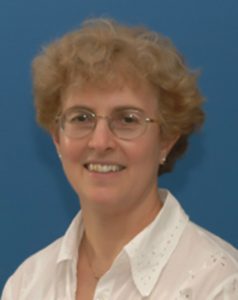
Professor Shadia Habbal
Institute for Astronomy
University of Hawaii
Honolulu, HI
USA
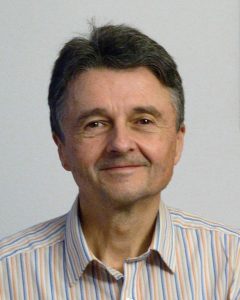
Professor Miloslav Druckmüller
Faculty of Mechanical Engineering
Brno University of TechnologyBrno
Czech Republic
Shadia Habbal is a Professor of Physics and Astrophysics, as well as Faculty Chair, at the Institute for Astronomy of the University of Hawaii. As part of her scientific research, she embarked on observations of the corona during total solar eclipses starting in 1995. Since the dimming of the sky during these events offers unsurpassed conditions for such observations, it was clear that total solar eclipses offered unique opportunities for exploring the properties of coronal structures, out to several radii above the solar surface. Known as the Solar Wind Sherpas, her team now includes up to 25 scientists, engineers and students, at any given event, as observations from multiple sites during eclipses have become imperative.
Her collaborator, Miloslav Druckmüller, is a professor of Applied Mathematics at Institute of Mathematics at Faculty of Mechanical Engineering at Brno University of Technology in the Czech Republic. His main specialisation is image analysis and image processing. A mathematician by profession, he is recognised worldwide as an avid photographer specialising in eclipse and astrophotography. He joined the Solar Wind Sherpas as a key member in 2006. The synergy of their collaboration has led to significant advances in understanding some of the clues of coronal structures, most notably the role of prominences, as described in this article.
CONTACT
FUNDING
NASA US National Science Foundation
KEY COLLABORATORS
Professor Adalbert Ding, Institute of Optics and Atomic Physics, Technische Universitaet Berlin, and Institute of Technical Physics, Berlin, Germany
Professor Huw Morgan, Aberystwyth University, Wales, UKMr Judd Johnson, Electricon, Boulder, Colorado, USAAssociate Professor Pavel Starha, Brno University of Technology, Brno, Czech Republic
FURTHER READING
M Druckmüller, SR Habbal, N Alzate, and C Emmanouilidis, Prominence-CME Systems Captured during the 2012 November 13 and 2013 November 3 Total Solar Eclipses, Astrophysical Journal Letters, 2017, 851, 41.
N Alzate, SR Habbal, M Druckmüller, C Emmanouilidis and H Morgan, Dynamics of Largescale Coronal Structures as Imaged during the 2012 and 2013 Total Solar Eclipses, Astrophysical Journal, 2017, 848, 84.
A Ding and SR Habbal, First Detection of Prominence Material Embedded within a CME Streaming away at 100 – 1500 km/s in the Corona, Astrophysical Journal Letters, 2017, 842, 7.
SR Habbal, H Morgan and M Druckmüller, Exploring the Prominence-Corona Connection and its Expansion into the Outer Corona using Total Solar Eclipse Observations, Astrophysical Journal, 2014, 793, 119.
SR Habbal, M Druckmüller, H Morgan, I Scholl, V Rusin, A Daw, J Johnson, MB Armdt, Total Solar Eclipse Observations of Hot Prominence Shrouds, Astrophysical Journal, 2010, 719, 1362.
Creative Commons Licence
(CC BY 4.0)
This work is licensed under a Creative Commons Attribution 4.0 International License. 
What does this mean?
Share: You can copy and redistribute the material in any medium or format
Adapt: You can change, and build upon the material for any purpose, even commercially.
Credit: You must give appropriate credit, provide a link to the license, and indicate if changes were made.
More articles you may like
Dr Alyson J McGregor | Uncovering the Gender Gap in Medical Research: How Sex Differences Impact Healthcare Outcomes
Medical research has historically focused predominantly on male subjects, leading to dangerous gaps in our understanding of how diseases and treatments affect women. Dr Alyson McGregor from University of South Carolina School of Medicine Greenville has devoted her career to addressing this critical issue, highlighting how biological sex differences impact health outcomes. Her work demonstrates that ignoring these differences can have life-threatening consequences and advocates for more inclusive research practices to ensure safe and effective healthcare for everyone.
How Food Environments Shape Our Eating Habits
How we eat dramatically impacts our health, yet millions of Americans live in ‘food deserts’ – areas with limited access to fresh, nutritious food. Recent research reveals that solving this crisis requires looking beyond just physical access to food to understand how our entire community environment shapes our dietary choices. Through a series of pioneering studies, Dr Terrence Thomas and colleagues at North Carolina A&T State University have been investigating how different aspects of our food environment influence what we put on our plates. Their findings suggest that creating lasting change requires reimagining how communities engage with food at every level.
Probing Electron Dynamics in the Ultrafast Regime
In the atoms that make up the matter around us, negatively charged particles called electrons have properties such as spin and orbital angular momentum. Researchers at Martin Luther University Halle-Wittenberg have developed a theoretical framework which allows them to simulate the dynamics of the spin and orbital angular momentum of electrons in materials when probed with an ultrafast laser pulse. Using this framework, they are able to simulate different materials and improve our understanding of dynamics on an atomic scale.
Seeing Beneath the Surface: Exploring Deltaic Reservoirs with Augmented Reality
In the Aínsa Basin of the Spanish Pyrenees, the Mondot-1 well was drilled, cored, and fully logged to capture a detailed record of a long-buried ancient river delta system. Dr. John D. Marshall, Dr. Jürgen Grötsch, and Dr. Michael C. Pöppelreiter with co-workers at Shell International used this core to trace how sediments once flowed across the landscape, and were deposited under shifting tectonic conditions. The team employed augmented reality and interactive virtual displays; these innovative tools offer new ways to explore subsurface depositional systems, and are particularly useful in locations where physical access to the core is difficult, or no longer possible.




